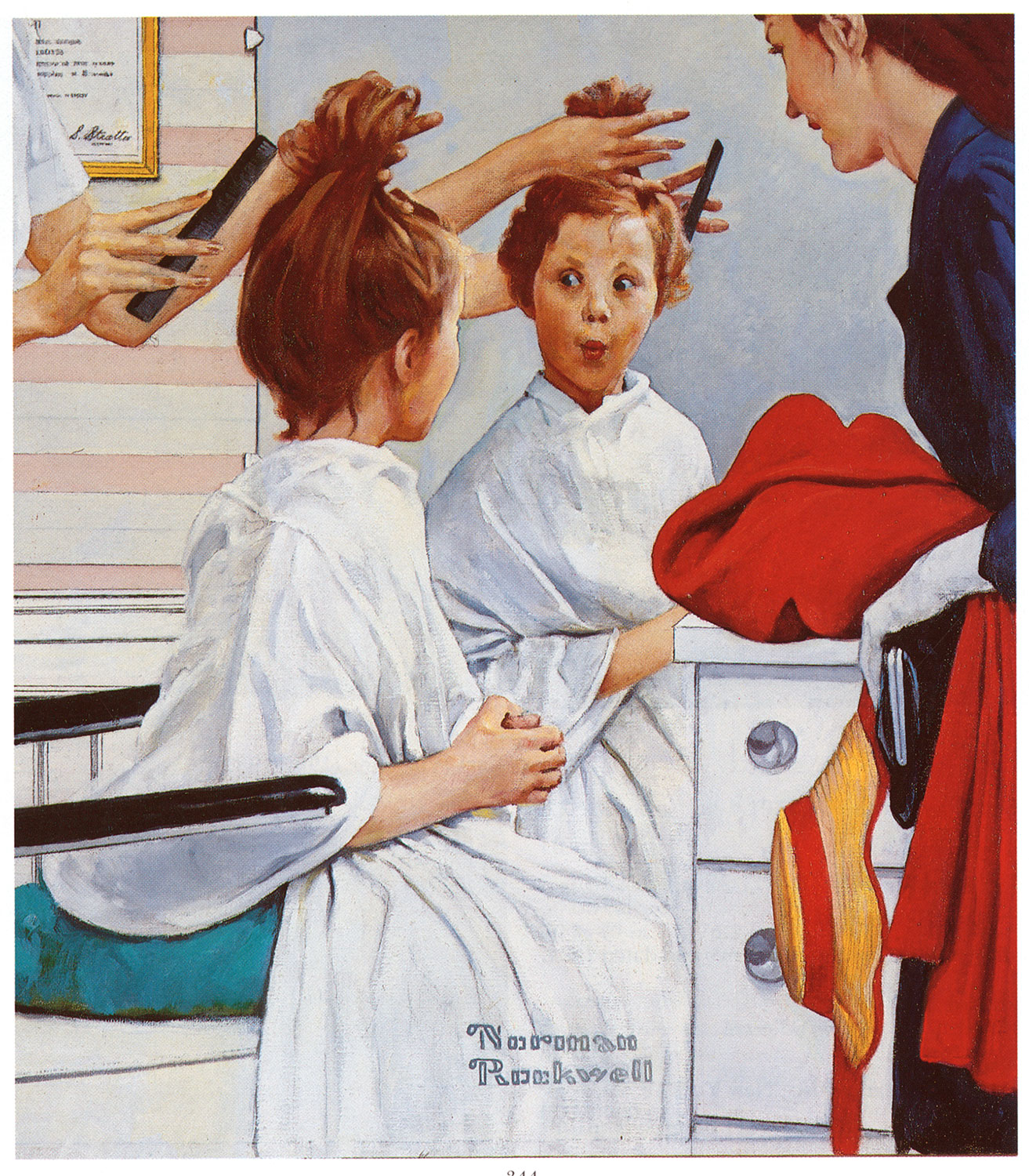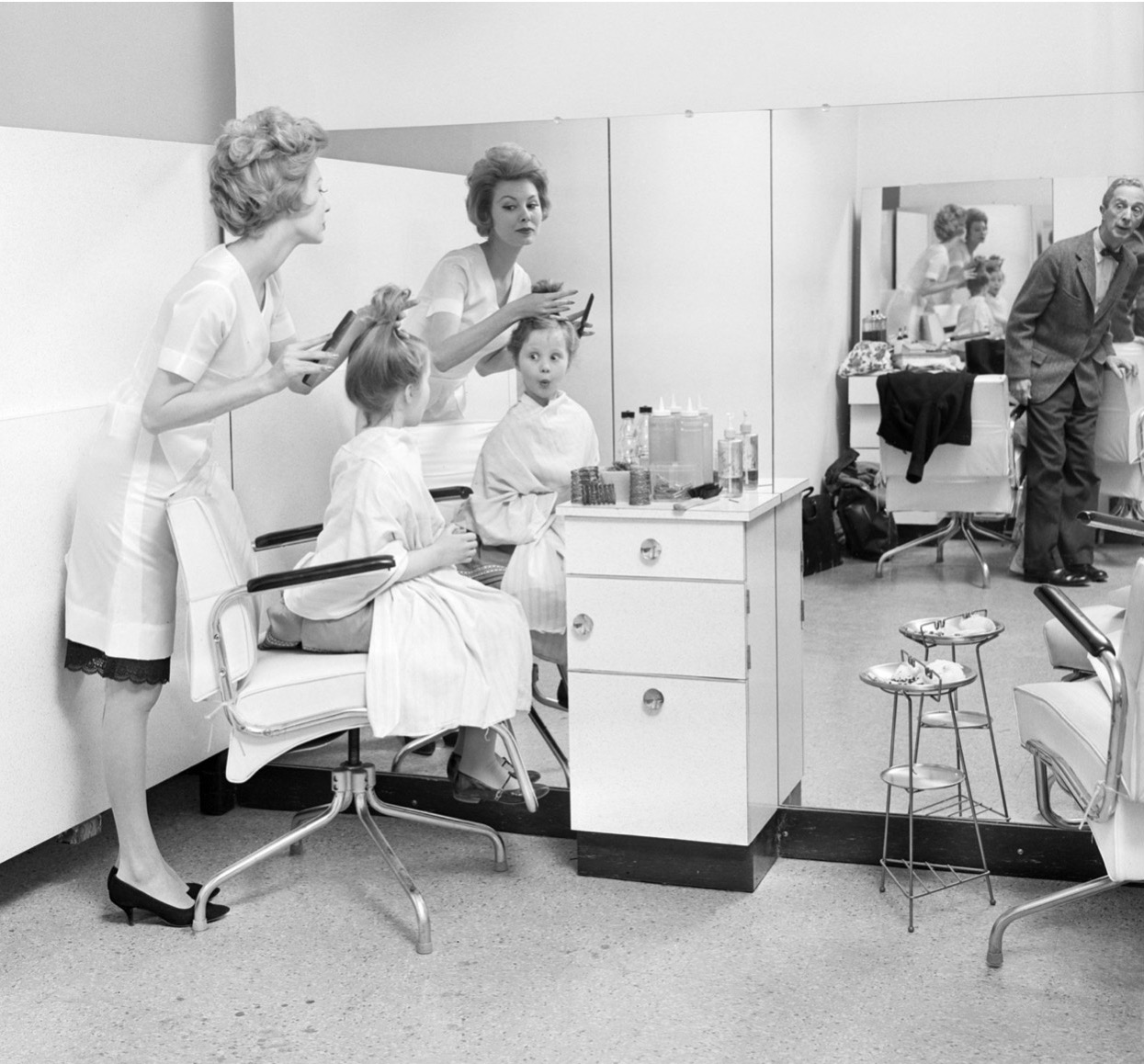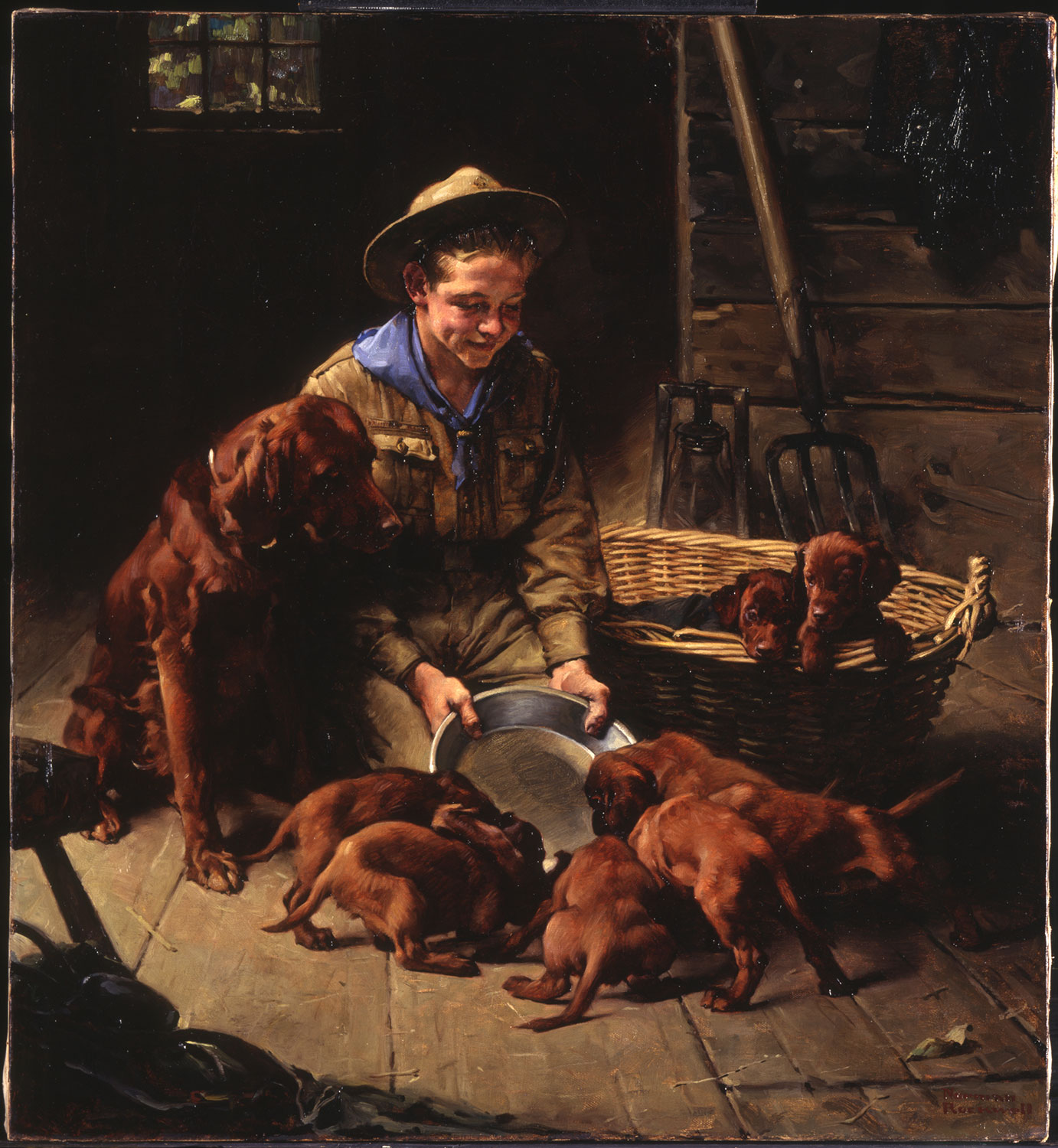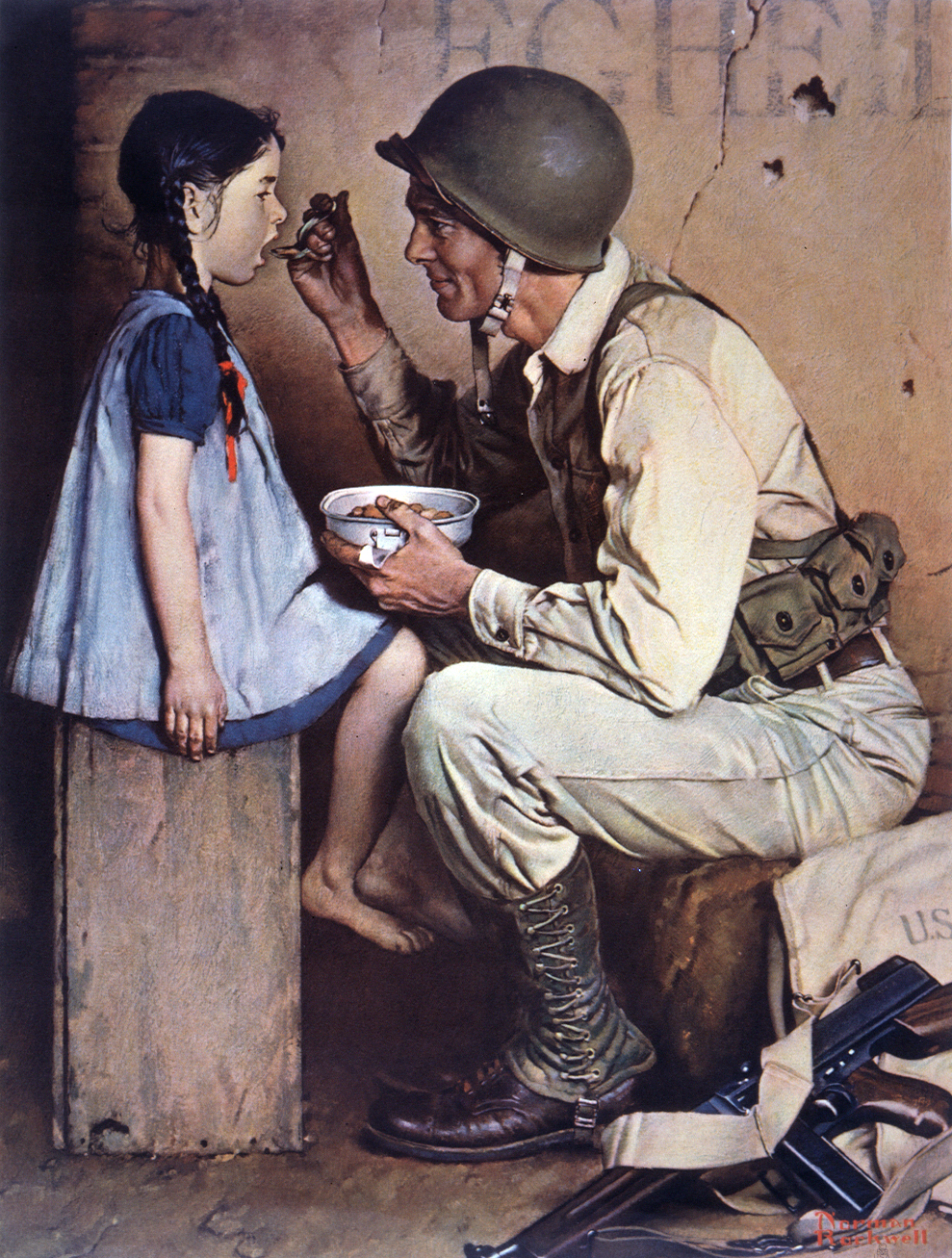Quick Pics: Compassion and Care - Weeks of 5/18/2020-5/25/2020
Overview - Compassion For Others
Big Idea for the Week
Staying curious, calm, and in conversation helps us develop understanding, compassion, and empathy for others.
Charwomen in Theater (Playbill) (1946)
Big Idea
Curiosity, wonder, delight, and participation in the arts, whether art, music, theater, dance or some combination, is for everyone and is a wonderful part of being human.
Notice and Wonder
- Who are these two women, where are they, and what are they doing?
- They are reading together from the same paper. They appear fully engaged.
- The seats around them appear to fold up. A gold colored plate on the rim of the seat has a number on it. The material is red velvet and there are wooden arm rests between the seats.
- Could this be a theater?
- We see a tissue and a paper with the word “playbill” in the foreground.
- Behind the women do you notice the seats are clean?
- A bucket with a brush sits next to one woman and there is a pole next to each of them.
- Is this a clue that there may be a broom or a mop at the end of the pole and these two women have the job of cleaners? Could they be half way through cleaning the theater?
- Notice the poles create a triangle. Norman Rockwell planned this to draw our eyes to the women.
- Take a close look at the expressions on the women’s faces. What story do they tell?
Fun Facts
- The name of this painting is Charwomen. This word describes someone who cleans for a living.
- The playbill is a paper people received walking into live theater productions. It includes the actors and the characters they play, a brief description of the play and information about scenes and intermissions which is a break between scenes for the audience to stretch.
- Rockwell entwined a sense of longing and desire in his wistful images of hardworking Americans who dream of their own time and resources to spend on activities that might not be accessible.
- Charwomen in Theater shows two custodians who take a moment to read the playbill and imagine the production. They appear deeply interested and curious.
- Of the illustration’s characters, filmmaker George Lucas observed: “It’s more to them than just a job. They’re interested in the place they work. You can imagine them sneaking up and watching shows” and “being proud that they work in the theater.”
- Rockwell invites us to imagine what spectacle has been brought to life, on stage and in the women’s minds.
- This work offers an intimate if imaginary glimpse into the lives of those working behind the scenes.
What You Can Do
Notice the small moments with others where you are completely involved and caring for each other. Make a play and invite your friends and family to watch. Notice theater, art, painting and drawing are for everyone. Taking a moment for an experience with the arts will offer you perspective and a chance to understand the world in new ways and with care and compassion for others.
First Trip to the Beauty Shop
(1972)
Big Idea
Today is May 16, 2020. Haircuts are on people’s minds as around the world hair cutting shops have been closed for a few months to create social distancing and slow the spread of Covid-19.
The haircut is a rite of passage and one of many conversations through life where children and parents are in conversation, ideally with care and compassion for one another, about how we present.
Notice and Wonder
- What do you think may be happening in this image? Does the title First Trip to the Beauty Shop begin to tell the story?
- Our eyes are drawn to the face of the young girl in the beauty chair. The hairdresser is holding her hair up and seems to be discussing the haircut about to happen with the adult who is likely the child’s mother.
- Have you ever been to a barber shop or hair salon, or had a family member cut your hair? Have you ever wondered what the haircut will look like before it is done?
- Notice Rockwell creates a double image. We see the girl seated in the chair as well as in the mirror.
- Notice that we don’t see the hairdresser, other than through her hands and comb.
- The mother, who is all dressed up for this special occasion, frames the girl on the other side of the picture. She is wearing white gloves which would have been typical for a special outing in the early 1970s when Rockwell created this picture.
Fun Facts
- Reflected in the beauty shop mirror is a glimpse of Norman Rockwell appearing in a favorite role, that of director. He was likely acting out the parts that his models would play to demonstrate the poses and expressions that he was looking for.
What You Can Do
Love your hair the way it is, and enjoy the rituals you create to take care of it.
Notice the feelings that come up around haircuts including the conversations with family members about what is the best haircut for the time. Hairstyles have changed throughout history. How we style our hair is an expression of who we are. Mothers, fathers and caregivers often have a strong idea about how they’d like children’s hair to look. As we grow older, each of us determines our own look.
Good Friends (1925)
Big Idea
Norman Rockwell’s message of friendship and care is expressed through the relationship of the boy and his dogs as well between the bonds that will form between the puppies.
Notice and Wonder
- What are the clues that the mother dog trusts the boy with her puppies?
- Notice how the mother dog sits quietly observing. She and the boy appear to be in connection with each other and equally focused on caring for the puppies.
- Notice how the boy is tipping a pie plate so the puppies can eat the last bits of food he has brought to them.
- Notice two puppies are content and in the basket observing. Their presence adds a sense of calm to the picture. It is easy to imagine all the puppies can expect to become full.
- What is the setting?
- Notice unpainted wooden floor and walls, two pitchforks, a small window which shows trees outside. Could the mother and her puppies be living in a barn?
- Notice the light in the picture, which falls in a circle highlighting the boy and dogs. Where is the light coming from? Might the barn door be open?
Fun Facts
- In this image of a Boy Scout feeding a litter of puppies.
- The setting is a New England barn most likely constructed of American Chestnut wood which is very rare today.
- Rockwell’s brush strokes make the silky feel of their new coats almost soft to the touch.
- Because the Boy Scouts calendar publication required about two years of production time, Good Friends was painted in 1925 for the 1927 season. It was Rockwell’s third in a series of fifty-one paintings used by the Boy Scouts of America as calendar illustrations and Boys’ Life magazine covers.
- The Boy Scouts of America gave Rockwell his first job and he was always grateful to the organization for that. Norman Rockwell created illustrations for the Boy Scouts of America for more than 50 years.
- The country setting of this scene is far from Rockwell’s own urban youth. He enjoyed country life and always enjoyed the time that his family spent during the summers on farms in upstate New York and on Long Island. Eventually, he moved to the country himself.
What you Can Do!
Think about the ways you can be gentle, caring and trustworthy for the animals around you. How will the animals in your home and community depend on you, and how will you notice them to also learn about their needs?
Tender Years (1957)
Big Idea
Small moments where we are truly present for each other are some of the most special.
Notice and Wonder
- The cat observes the scene and with the hot water bottle, vaporizer and kettle for heating water creates a semicircle. This semicircle frames the scene and draws our eye up to the action of the steam rising from the tub.
- Notice the man is soaking his feet in the tub. Our eyes follow the rising steam and we notice the man is wrapped in a colorful quilt.
- How can you tell the man wants to feel better? Notice how wide he is opening his mouth so that the medicine can go down easily.
- The woman appears organized and present. She has medicine to give, and she is leaning in to make sure every drop gets to the right spot.
Fun Facts
- Norman Rockwell created illustrations for magazines, and that was what he became best known for. He also created artwork to advertise all kinds of products, from cars to pens and life insurance.
- Norman Rockwell also created artwork for calendars, especially the Brown and Bigelow Company, which is located in St. Paul, Minnesota.
- Brown and Bigelow published Rockwell’s Boy Scout Calendar illustrations for more than fifty years, as well as a series of Four Seasons illustrations inspired by different aspects of life at different times of year, like this image focused on caring for a loved one who has a winter cold.
- Calendars are useful tools to keep our schedules on track, and even today, they are often given as gifts by businesses in appreciation for their customers. In 1957, just about every household would have had an illustrated calendar to remind families of important things that were coming up. How about you? Do you have an illustrated calendar, or is yours digital these days?
What You Can Do
Think about what you can do to make another person cozy, comfortable or cared for today. It might look like making food, doing dishes, giving medicine or helping with a chore. Give some of your time or energy for someone else.
The American Way/Soldier Feeding Little Girl (1944)
Big Idea
Even in the most difficult situations we can take time to care for one another.
Notice and Wonder
- Notice the background and the uniform on the man. What are the clues that he is a soldier and it is wartime? Notice the cracked wall, lettering on the walls, and possible bullet holes.
- What is the soldier doing?
- What is the young girl doing?
- Where are they?
- What do their feet tell us?
- The soldier is wearing gators which protect his feet and legs from cold and water. The girl has no shoes.
- Notice the soldier is crouching so he is at eye level with the girl who is sitting up on a box. There is a sense of both respect and care between them. The girl is sitting up straight and accepting the soldier’s food. He smiles and stays at eye level, with his gear set aside, while he focuses on feeding her with his rations.
- Do you think Norman Rockwell was telling a story of caring for one another with this image? What are the clues?
Fun Facts
- During World War II, Rockwell produced many images of soldiers, but mostly in humorous situations or helping others. This image was made for an advertisement for Disabled American Veterans.
- Norman Rockwell created just one illustration of a soldier in battle, but said he did not like to portray violence no matter the cause.
- During World War II, the Veterans Rehabilitation Act did not provide enough money to assist injured veterans with their healthcare and needs.
- This poster illustration, created for an organization that helped disabled veterans, was meant to convey the important life-saving work that soldiers have done throughout the world, and to inspire people to make donations to help with their care.
- Rockwell's advertising career started in 1914 with a Heinz ad in the Boy Scout Handbook and ended 64 years later in 1976 with Lancaster Turkeys. During his lifetime, he provided artwork for the advertising campaigns of more than 150 companies, from cars to socks, cereal, pens, and more.
- Rockwell’s ability to touch his viewer's emotions was prized not only by magazine art editors, but also by advertisers.
What You Can Do
Notice the people in your community who help others - soldiers, healthcare workers, teachers, all the people who keep our communities running. Let them know you are grateful for their service.
Image Resources
Charwomen in Theater (Playbill), (1946)
First Trip to the Beauty Shop, (1972)
First Trip to the Beauty Shop (Reference Photo), (1972)
Good Friends, (1925)
Tender Years, (1957)
The American Way/Soldier Feeding Little Girl, (1944)
Image Credits:
Charwomen in Theater (Playbill), 1946
Norman Rockwell (1894 - 1978)
Oil on canvas
Cover illustration for The Saturday Evening Post, April 6, 1946
© 1946 SEPS Curtis Licensing, Indianapolis, IN.
First Trip to the Beauty Shop, 1972
Norman Rockwell (1894 - 1978)
Oil on canvas
Story illustration for Top Value Stamps, 1972
© 1972 Norman Rockwell Family Agency
Good Friends, 1925
Norman Rockwell (1894 - 1978)
Oil on canvas
Illustration for Boy Scouts of America Calendar, 1927
Norman Rockwell Museum Collection
© 1925 Norman Rockwell Family Agency
Tender Years, Treating a Cold, 1957
Norman Rockwell (1894 - 1978)
Lithograph
Four Seasons calendar illustration for Brown & Bigelow, 1957
© 1957 Brown & Bigelow
The American Way (Soldier Feeding a Girl), 1944
Norman Rockwell (1894 - 1978)
Oil on Canvas
Advertisement for Disabled American Veterans, 1944
© 1944 Norman Rockwell Family Agency
- Grade
- K-6
- Theme
- Quick Pics
- Length
- Each Quick Pic activity is about 5-10 minutes in duration, with each being taught one image per day over a week.
- Discipline
- Social Studies, Language Arts: Speaking and Listening, Art
- Vocabulary
- Hero; Heroes, Doctors, Workers, Teachers, All of Us
Standards
This curriculum meets the standards listed below. Look for more details on these standards please visit: ELA and Math Standards, Social Studies Standards, Visual Arts Standards.
- CCSS.ELA-Literacy.CCRA.L.1
- Demonstrate command of the conventions of standard English grammar and usage when writing or speaking.
- CCSS.ELA-Literacy.CCRA.L.2
- Demonstrate command of the conventions of standard English capitalization, punctuation, and spelling when writing.
- CCSS.ELA-Literacy.CCRA.L.3
- Apply knowledge of language to understand how language functions in different contexts, to make effective choices for meaning or style, and to comprehend more fully when reading or listening.
- CCSS.ELA-Literacy.CCRA.L.4
- Determine or clarify the meaning of unknown and multiple-meaning words and phrases by using context clues, analyzing meaningful word parts, and consulting general and specialized reference materials, as appropriate.
- CCSS.ELA-Literacy.CCRA.L.5
- Demonstrate understanding of figurative language, word relationships, and nuances in word meanings.
- CCSS.ELA-Literacy.CCRA.L.6
- Acquire and use accurately a range of general academic and domain-specific words and phrases sufficient for reading, writing, speaking, and listening at the college and career readiness level; demonstrate independence in gathering vocabulary knowledge when encountering an unknown term important to comprehension or expression.
- CCSS.ELA-Literacy.CCRA.SL.1
- Prepare for and participate effectively in a range of conversations and collaborations with diverse partners, building on others' ideas and expressing their own clearly and persuasively.
- CCSS.ELA-Literacy.CCRA.SL.2
- Integrate and evaluate information presented in diverse media and formats, including visually, quantitatively, and orally.
- CCSS.ELA-Literacy.CCRA.SL.3
- Evaluate a speaker's point of view, reasoning, and use of evidence and rhetoric.
- CCSS.ELA-Literacy.CCRA.SL.4
- Present information, findings, and supporting evidence such that listeners can follow the line of reasoning and the organization, development, and style are appropriate to task, purpose, and audience.
- CCSS.ELA-Literacy.CCRA.SL.5
- Make strategic use of digital media and visual displays of data to express information and enhance understanding of presentations.
- CCSS.ELA-Literacy.CCRA.SL.6
- Adapt speech to a variety of contexts and communicative tasks, demonstrating command of formal English when indicated or appropriate.





